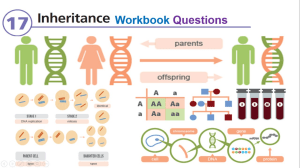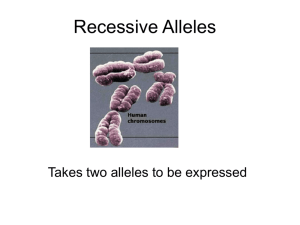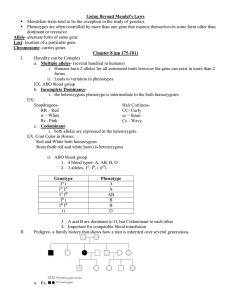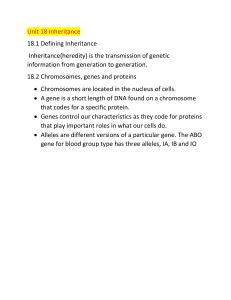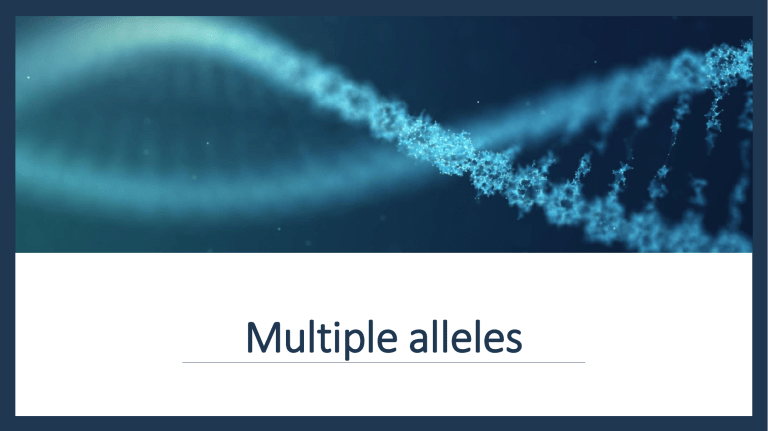
Multiple alleles Multiple Alleles • Alleles can be defined as genes that are members of the same gene pair, each kind of allele affecting a particular character somewhat differently than the others. • In Mendel's experiments there were two possible kinds of alleles in a gene pair, i.e, smooth or wrinkled (S,s) yellow or green (Y, y) • There are more than only two possible kinds of alleles in a gene; hundreds or perhaps thousands of possibilities exist. • The grouping of all different alleles that may be present in a gene pair is defined as a system of multiple alleles. Multiple Alleles • Dominance in this series appears to be incomplete, although it would be difficult to make such a decision without this type of refined analysis. • Alleles of this type which act within the same phenotypic range of each other have been termed isoalleles. • Some of these alleles has also been discovered in abnormal character, mutant isoalleles and some within the phenotypic range of wild type, normal isoalleles. • A multiple allele system may therefore be quite complex, including within it various subsidiary isoallelic systems. Multiple allelic blood group systems MultipleAllelic BloodGroup Systems. • In animals, tissues that are removed from one individual and grafted onto another are frequently sloughed off or rejected because of incompatibility between the introduced material and that of host. • In 1947, Walsh and Montgomery found that a certain portion of human blood serum could be used to distinguish new varieties of MN blood system. • There appear to be four codominant alleles LMS, LMs, LNS, LNs, (or MS, Ms, Ns, NS) which would give nine different phenotypic combinations. MultipleAllelic BloodGroup Systems The first case of multiple alleles demonstrated in man was really that of another blood group system which has been discovered by Landsteiner and his students in early 1900s. This system called ABO was shown by Bernstein in 1925 to consist of three alleles of a single gene, IA, IB and IO forming four different phenotypic groups: A(IAIA or IAIO), B(IBIB or IBIO), AB(IAIB) and O(IoIo). In this case, the blood serum of man himself manufactured the antibodies that reacted with the blood-cell antigens of other individuals. Multiple-Allelic Blood-Group Systems • According to Kabat, Watkins and others it is the terminal sugars of these compounds which differ between the A and B antigens. • The A substance bears an N-acetyl group at the number 2position of the galactose sugar; the B substance carries a hydroxyl group at this position and the O substance lacks the terminal galactose sugar entirely. • The distinction between the A and B substances thus arise from the distinctive difference in the kinds of terminal galactose sugars transferred to a precursor substance by the action of the a and B alleles; each allele produce transferase enzyme but one function as an Nacetyl galactosaminyl transferase(A) and other as galactosyl transferase(B). • In case of O, no terminal transferase enzyme appears to be produced and it can therefore be called a null allele. MultipleAllelic BloodGroup Systems • In respect to A and B, we can see the antigenic differences, although small, are nevertheless significant, so that antibodies can discriminate between one antigen and the other. • In fact, additional multiple alleles at the ABO locus have recently been found (A2, A3, Ax and Am) which probably differ in even more minor respects. • According to Stormont, the number of different alleles for a particular blood type gene called B reached more than 300. RH and ABO incompatibility The agglutination reaction that occurs when red blood cells are clumped by serum antibodies may also occur in the circulation of the mammalian embryo having a blood type antigenically different from its mother. RH and ABO incompatibility The first instance of such compatibility was noted in checking the blood types of children born with serious anemia (erythroblastosis fetalis or hemolytic disease of the newborn) caused by the breakdown (hemolysis) of their normal red blood cells. Before 1940, this disease was present in about one out of 200 births. As determined by Levine and others, these children had a blood type, Rh positive, inherited from their fathers, but antigenically different from their Rh-negative mothers. RH and ABO incompatibility This Rh factor, first detected in the red blood cells of Rhesus monkeys, was initially thought to be caused by a gene with only two alleles, R and r. The events leading to erythroblastosis thus arose from the Rhnegative genotype of the mother (rr) producing antiserum against the antigens of the Rh-positive offspring(Rr) Since the R allele acted as a dominant to r, Rh positive males married to Rh negative females could have either all or half their offspring phenotypically Rh positive depending on parent's genetic constitution was respectively homozygous (RR) or heterozygous (Rr). Anti D Injection • Brief detail about anti D injection RH and ABO incompatibility • The Rh blood group is only one of the systems which may cause mother-offspring incompatibilities. • Other blood group antigens may also travel across the placenta and produce maternal antisera. • Rh incompatibility is estimated to occur in about 10 percent of all pregnancies; nevertheless, only 1/20 to 1/50 of these incompatible offspring turn out to be affected by hemolytic anemia. • This diffusion not seem to occur very frequently and even when it occurs the amount of diffused antigen may be low enough so that the amount of maternal antibody production is not very high. • Although Rh incompatibility may exist between mother and offspring, ABO incompatibility may prevent anti-Rh serum from developing. RH and ABO incompatibility • Incidence of Rh hemolytic disease occur when mother and offspring are compatible for the ABO blood groups. • When they are incompatible, and the diffusing fetal cells can be destroyed by maternal ABO antibodies, the frequency of Rh hemolytic disease decreases.
